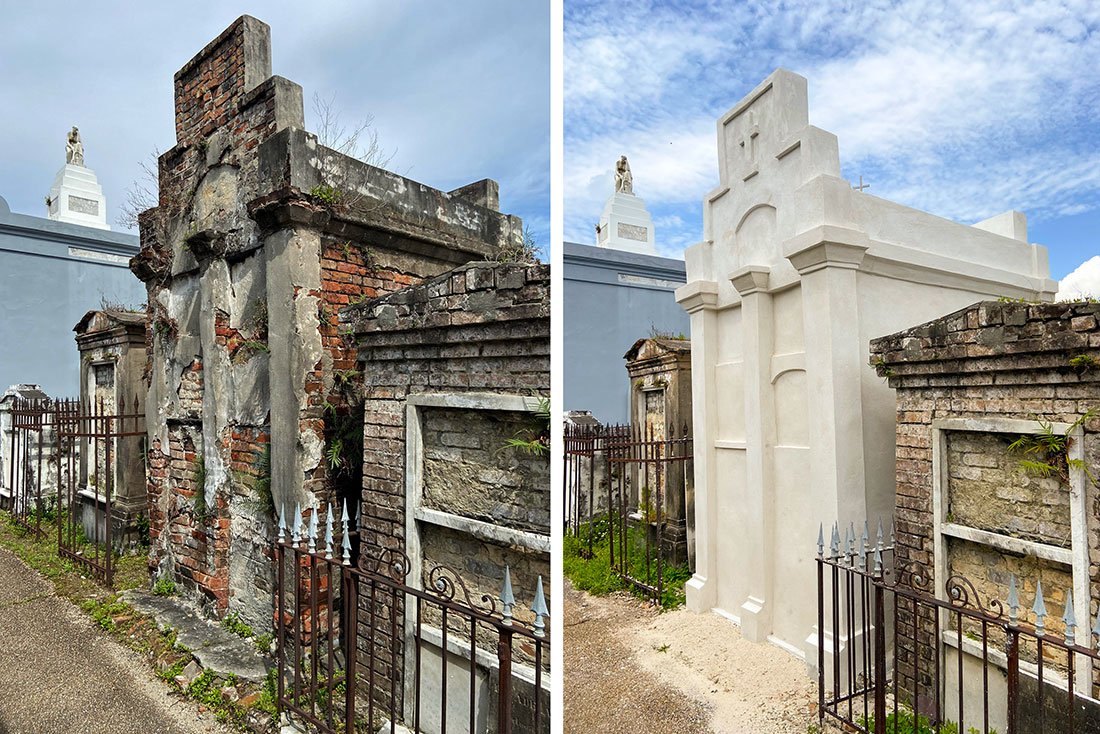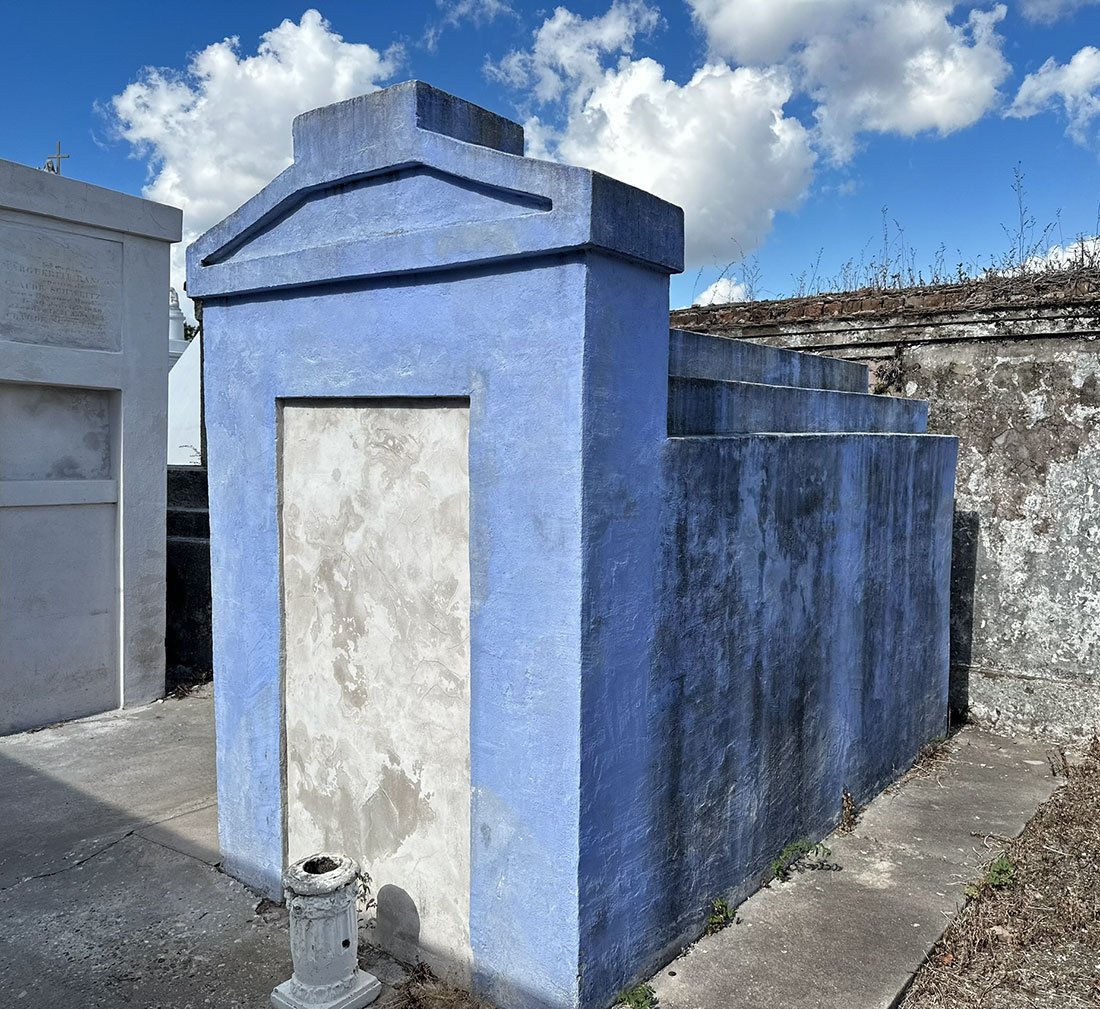Giving the Dead Their Due: The Abandoned Tomb Initiative
October 2023Marie Laveau’s tomb in St. Louis Cemetery No. 1 was one of the first to be restored in a unique initiative that cares for New Orleans’ fabled Cities of the Dead.
– by Reda Wigle
photos by Heather Veneziano and Ellis Anderson The word cemetery derives from the Greek koiman, to put to rest. Heather Veneziano, consultant for the New Orleans Catholic Cemeteries Abandoned Tomb Initiative, is ensuring the dead denizens of New Orleans rest peacefully.
The Abandoned Tomb Initiative was established in 2017 by the executive director of New Orleans Catholic Cemeteries, Sherri Peppo to address the problem of dilapidated and damaged tombs in the city’s Catholic cemeteries. Cemeteries are commonly known as “cities of the dead,” and for Veneziano, the description is apt.
photo by Ellis Anderson
“In a city everyone is responsible for the upkeep of their own house,” she said. “And whatever you have to do to your own house to fix it up is your responsibility. Tombs function the same way in the city of New Orleans. The property owner of the tomb is required to keep up their tomb, they’re in charge of the maintenance and restoration of it.”
Oftentimes, family members of the deceased or religious societies operate as tomb owners and maintainers but problems arise as time spins onward.
“St. Louis No. 1 dates back to 1789,” Veneziano said. “As you can imagine, there are plenty of families that no longer exist – whether they died out or moved away – so we are left with a plethora of what we call abandoned tombs.”
The “before” picture of the tomb shown in our headline image, photo by Heather Veneziano
photos by Heather Veneziano
The initiative project defines an abandoned tomb as one in poor condition without a family contact on file and no internments made within the last 50 years. According to Louisiana law, a cemetery operator can actually reclaim abandoned tombs, transfer the remains and resell the tomb.
Since cemeteries owned by the New Orleans archdiocese don’t take things to that extreme, it leaves many tombs that are in need of restoration - hence the program. Veneziano notes the program wants to “honor those remains in place.”
photos by Heather Veneziano
Tombs deemed abandoned and eligible are repaired using the National Parks Service guidelines for historic restoration. Veneziano explained that if the tomb was constructed initially out of soft river clay brick and lime based plaster, those same materials are used for the restoration. If multiple layers of cement or latex paint have been slathered on over the decades, restoration teams remove that as much as possible so they can start fresh with historically appropriate materials at the tomb’s core structure.
Ironically, given the context and content of a tomb, breathability is the top priority for restoration.
“Portland cement, latex paint and other contemporary materials create a moisture barrier on the tomb. When water seeps into the tomb from the ground or from the climate in general, it can’t escape. It tries to push out in any way and eventually the softest material – the historic brick – will go. That’s why you see so many tombs crumbling, because of inadequate materials that were put on top of the structure.”
photo by Heather Veneziano
photos by Heather Veneziano
Veneziano holds a Master of Fine Art from the University of Edinburgh and a Master of Historic Preservation from Tulane University. She currently serves as a Professor of Practice and Director of the Historic Preservation Program of Tulane School of Architecture and operates the historic preservation consulting firm of Gambrel & Peak. She views tomb restoration as both a civic responsibility and a cultural imperative.
Veneziano and her youngest child in St. Louis Cemetery, No 1., 2023, photo by Ellis Anderson
One of the oldest wrought iron crosses in St. Louis Cemetery No 1, photo by Ellis Anderson
“The architecture of this city is so unique and it’s the same with the memorial architecture. All of our past citizens are here. The history of the city is encapsulated within the cemeteries... We try and connect the stories of the people who are buried in the cemeteries to the larger narrative of the city and we want to keep these tombs in shape in order to honor these individuals.”
Veneziano first collaborated with Catholic Cemeteries on the tomb restoration of one of our city’s most storied citizens, Marie Laveau. Laveau’s tomb has faced chronic defacement since the early 1900s, when tour guides began encouraging visitors to mark it with three x’s and three knocks, promising a granted wish in return.
The restored tomb of Marie Laveau is still being defaced by people carving onto the tomb’s surface, a practice her family would like to see discontinued. Photo by Ellis Anderson
The practice has nothing to do with Voodoo and was simply an invention of guides trying to make the experience more exciting for tourists, according to Veneziano.
“We’re still dealing with those repercussions today. When things are done for so long, it becomes truth in the mind. It’s a difficult thing to combat,” Veneziano explained.
In 2013, a vandal took defacement to new heights, and color palettes, painting the entirety of Laveau’s tomb with bubblegum pink latex paint.
“It was a call to action,” said Veneziano who restored the tomb as part of a team led by local conservation company Bayou Preservation – in the high heat of summer amidst a crowd of curious onlookers. “It was interesting from a cultural perspective to consider what draws people to this tomb.
“We adopt a lot of these historical figures like they are a part of us all and Marie Laveau is an example of that. We feel connected to her because we live in this city, but you have to think that she’s also someone’s direct family member. That connection is stronger, and her family really wants the practice to stop.”
The restoration of Laveau’s tomb coincided with the closure of St. Louis Cemetery #1 to the public outside a guided tour, a decision Veneziano supports, “The reality of having a historic site unmanned in the middle of the city was challenging. Now, if we do restore the tombs, they will be safe.”
To that effect, Veneziano sees both the danger and value of cemeteries as destinations for tourists. “A lot of times we look at cemeteries as landscape, as beautiful architecture. It’s easier to do that because no one wants to think about death.
“In general, when they’re viewed as places to visit and interesting stops for tours. That’s wonderful, but you have to always remember that these are cemeteries that people use on a daily basis to mourn. I think that sometimes gets washed away.”
The oven vaults where it’s believed that the country’s first female choreographer, Suzanne Douvillier, was buried in 1826. Click on the image to read about her life. Photo by Ellis Anderson
The success of the Laveau project led directly to the later establishment of the abandoned tombs initative and Veneziano hopes, a restored respect for the city’s cemeteries as a whole.
Readers will be relieved to know that Laveau’s cemetery neighbor, actor Nicolas Cage, has a fool-proof plan for the upkeep of his final resting place. The Ghost Rider himself has placed his memorial pyramid under perpetual care, a system in which a lump sum of money is placed in a trust. The interest gained from that money is used for tomb maintenance. Establishment of perpetual care is encouraged, as no one knows if their future family a century up the road will be able to afford care for the tomb.
Nicholas Cage’s pyramid tomb in St. Louis Cemetery No 1, is near Marie Laveau’s tomb, photo by Ellis Anderson
Veneziano’s draw towards, and drive to protect, cemeteries is rooted in a reverence for stories. Her love of history and the people of the past make her see historic tombs and buildings as beautiful examples of craftsmanship and design that reflect the sensibilities of their designers, builders and laborers responsible for creating them. She’s “invested in uncovering their stories.”
Among the stories she has uncovered is that of the craftsman behind the tombs. “On the bottom right hand corner of a lot of the tablets will be the carver’s signature. A lot of those guys had really fascinating lives when you start researching them; they owned marble yards. Many of them were free men of color or first generation German or Irish immigrants.”
The earliest known image of St. Louis Cemetery No. 1 is a watercolor created in 1834 by Henry Latrobe and it shows many tombs painted in colors. Today, colors are discouraged because the upkeep requires much more maintenance. Photo by Ellis Anderson
In Veneziano’s estimation, the cemeteries of New Orleans are an extension of the rich and varied nature of the city itself. “Our tombs are above ground partially because of the water table, but mostly because we are a city governed early on by both France and Spainalo. I think it defines us as ‘other’ in the sphere of this country. It places us more in the Caribbean and other locales that were also colonized by France or Spain, where you will find very similar mortuary architecture."
Two thousand years before New Orleans had a cemetery to call its own, the philosopher Confucius advised that “we keep the dead before our eyes and honor them as though still living.” With every brick restored and story uncovered, Veneziano and the Abandoned Tomb Initiative make certain that the dead who have built the city – and upon whom the city is built – are both seen and honored.
For more information and to donate visit nolacatholiccemeteries.org/abandoned-tombs.
Join our Readers’ Circle now!

















